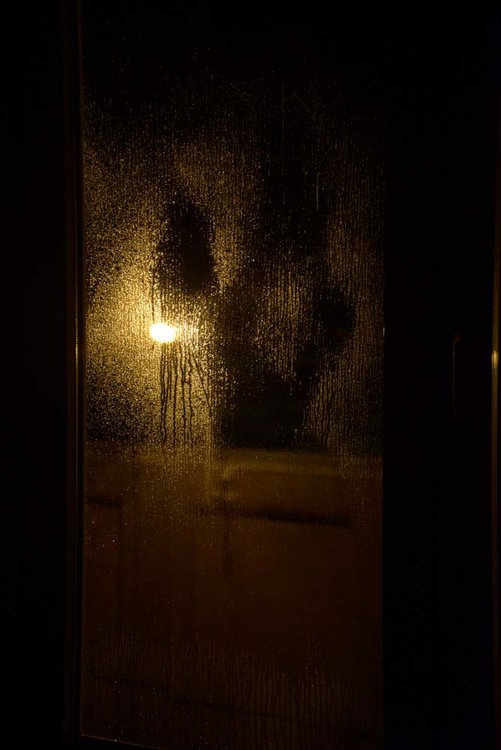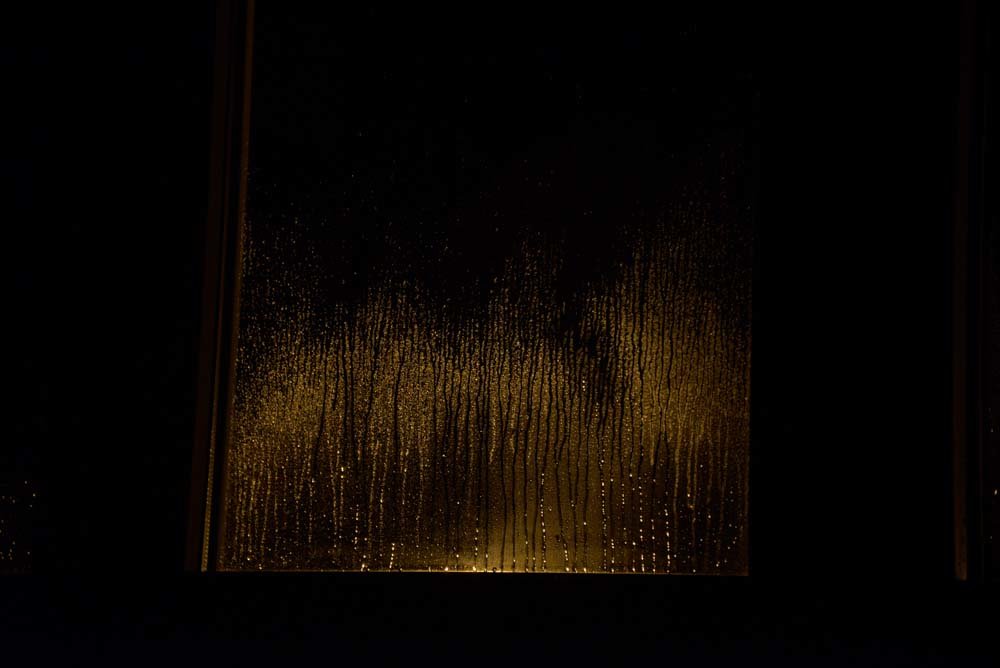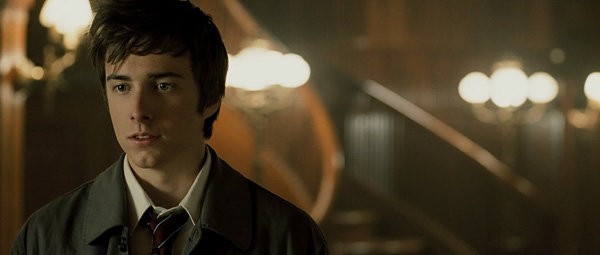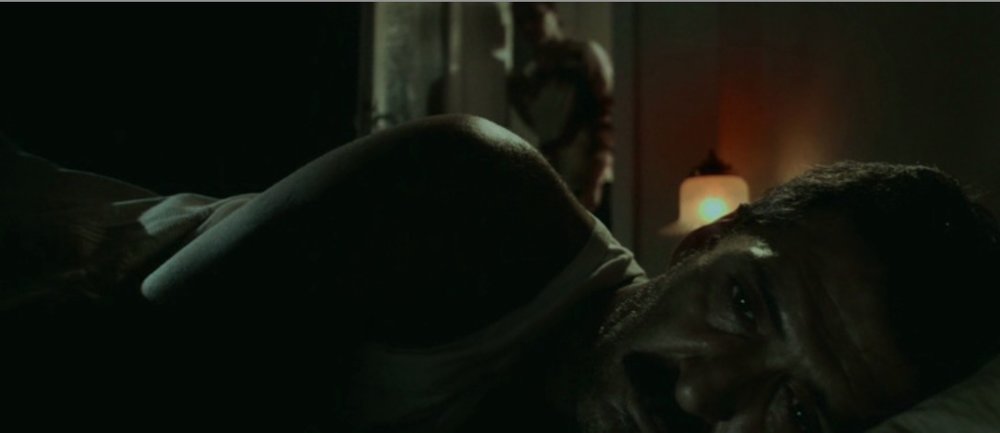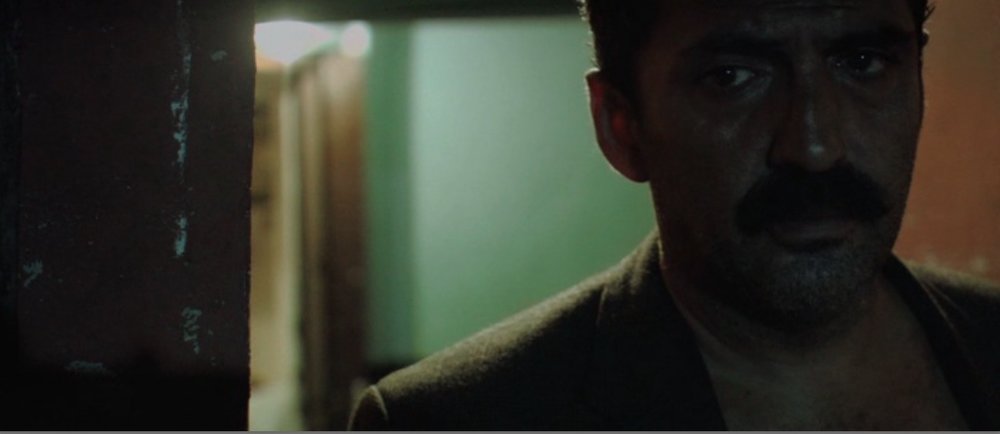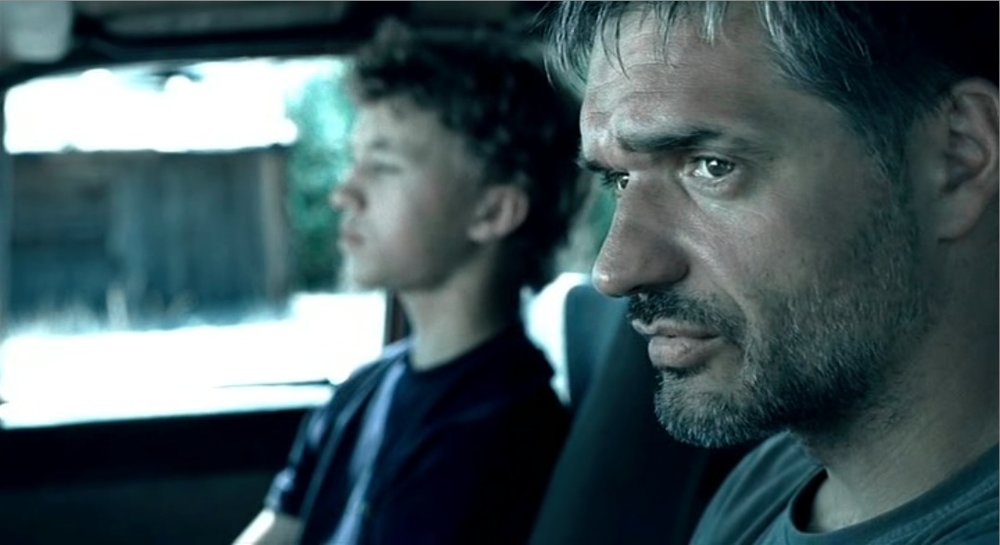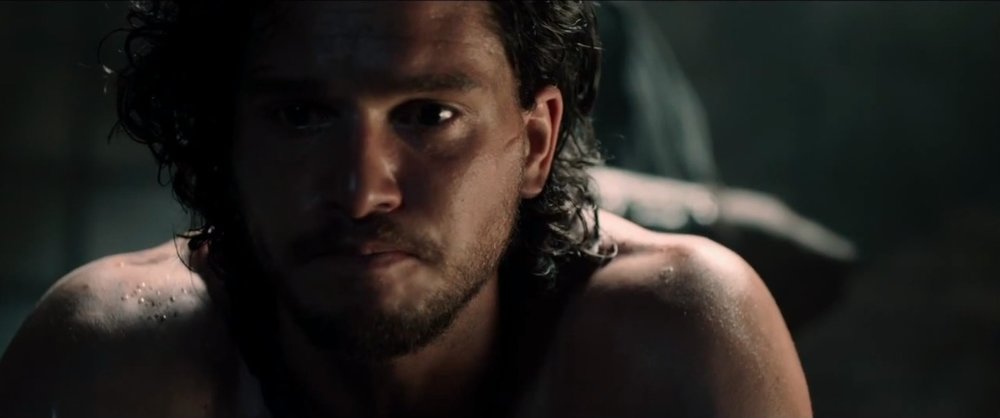-
Posts
10 -
Joined
-
Last visited
Everything posted by Raphael Van Sitteren
-
I also agree with you two about backlighting :) My idea was to backlight the drops with the muslim or kino... something out of the image hidden below the car door. But that's when i'm starting to question the idea because I feel that the source being out of frame will tend to make the effect disappear. I'm looking out my window right now, I just sprayed it totally with water. I can only see the drops that are very close (in terms of axis) from the streetlight in the background. The drops form some kind of radius around the streetlight as you can see below, the more I look away from the light, the less obvious the drops tend to be. Now i kneel down, so that the streetlight is hidden below the window (like I intended to do with the kino hidden behind the car door) The radius still applies of course (kneeling down doesn't affect physics unfortunately). The drops only appear in the bottom of the window (though the water is evenly applied on the window, like the previous picture), showing clear evidence that there is a hidden source down below, so much for subtlety :D My conclusion from this observation : Drops act like lenses, yes... but probably a longer lens that I thought <_< So I need motivated light sources in frame to make drops appear on a dark background. Of course the background is pitch black in these examples. It's not gonna be that extreme in the sequence, and any part of the background that isn't black is also going to show water drops in negative (dark drops on light background) which is okay for me too I guess. Feel free to develop on these conclusions
-
I'm shooting a night time scene with 2 characters talking inside a car. The car is parked, the windows are wet from a recent rain (but it's not raining anymore). I'm looking for tips and advices for enhancing the water drops. Here is a screen grab from tests I've shot on a 5D a couple of days ago in a studio (we're gonna shoot on location for the actual shoot, with a RED One) with the kind of lighting atmosphere I'm planning to do. No one was really in charge of the rain drops for this test, so we just splashed water on the window before shooting. My first question is about the best solution for spraying water on the windows. I was actually thinking of using a water sprayer filled with a mix of water and glycerine (like we usually use for sweat on faces). Any other idea or advices for the best mix to put in the tank ? My second question is about lighting those drops. I know that you don't actually light raindrops as they are transparent, you just need them to register an image as they act like a lens. I don't want to have a very lit background (probably a bit darker than the test shot) to keep the drops brighter than the background itself. My idea was to shine light on a large muslim sheet (or a kino 1 bank) placed low behind the car, so it doesn't affect my lighting and contrast inside the car and create a white line on the top of the drops so they exist on this dark background. I guess they will probably also register the lights I use for lighting the characters. Am I on the right track ? I'd love to also add some colour bokeh with a small fixture far away in the background. What kind of source would you use for that ? The director wants to place the car close from a (white :blink: ) house wall, I'm pushing to place it further so we have more depth in the back and we can isolate the 2 characters in the image. Any advice or comment on my ideas are more than welcome ;) Thanks
-

Best camera for a documentary?
Raphael Van Sitteren replied to Adam Symes's topic in Camera Operating & Gear
My comment is not based on specs but on testing the 2 beasts. When you compare side by side a C300 and a Sony F5 (both in log), there is an obvious difference. The F5 responds better in terms of color, sensitivity, and dynamic range, that's a pure fact. MP me, I can send you the link of the test I've done if you're interested. I needed to compare those 2 cameras for shooting a sequence of a documentary shot in extremely low light situation (litterally one candle light at some point) and we ended up shooting with the F5, and I must say it was the best choice for that situation and this camera really amazed me. I'm not gonna bash the C300. I've done my share of shooting with that camera and I also like it. I got over it's weird form and the not so logic function buttons, and I made some really great looking images with it, and will continue using it when the projects demands that sort of camera, lighter and more "run and gun" but with a large sensor. The F5 is a newer generation, from a key video company, and is a bit more expensive, it's fair to expect a better product, right ? -

Best camera for a documentary?
Raphael Van Sitteren replied to Adam Symes's topic in Camera Operating & Gear
I think the first question you have to ask yourself (in term of image) do I need (can I afford....in terms of feasability not budget) a large sensor or not ? BMCC is being sort of in the middle between large sensors and EX1/ EX3 type of cameras. It all depends on the subject and the type of shooting you're about to face. Run and gun situations all by yourself don't call for large sensor as you'll struggle with focus all the time and end up throwing most of the material away. On the other side, controlable and settled situations, repeatable actions, an assistant, would allow you to spend more time polishing the image. Your subjects dictate that choice more or less. 2K is not a big step up from 1080p so I wouldn't base my choice on that criteria. If you don't go for large sensors then EX1 and EX3 are the way to go, very good cameras, sturdy workflow and many creative options. I prefer the EX1 ergonomics but it's just me, the EX3 has TC IN though. You can record on an external recorder (Ninja / Blackmagic Shuttle / Soud Device) to enjoy 4:2:2 recording, which will give you a bit of room for grading. If you go for large sensors, then you have to ask yourself another question : is sensitivity relevant ? BMCC is not really good regarding sensitivity so if you shoot in low light conditions, don't ever consider it. If you still lean for the BMCC after this, consider all the rig addition that is involved with this camera (and the battery issues...) The Sony F5 is 2000 ISO without any gain, and you can easily push it 6400 without any problem if necessary, so if sensitivity is important, best choice ! The Sony F55 is a but less sensitive 1250 due to global shutter, but has a better color rendition... but you said budget has to be reasonable so maybe stick with the F5. The C300 is not as good as the F5 in terms of sensitivity, dynamic range and color reproduction...and the form factor is a bit weird (some people get used to it... I did anyway). But it's a bit cheaper than the F5, medias and batteries are also less expensive, smaller and easier to handle in post production, it's also a key factor to take into account if you need to travel a lot. You'll have an inferior image compared to the F5 (but still very good looking...) but will travel lighter, and eat better food with all the money you saved. If I had to chose a documentary camera with a large sensor now I'd go for the F5 but it would depend on the conditions of the shooting I mentioned all along this post. Life is all about choices anyway... ask yourself the good questions and when you have made your decision don't look back and just make the best out of the tool you chose ! -
Thanks David all of this makes perfect sense. When I was saying that I didn't want to fix it in post I didn't mean it was not relevant, I simply wanted to focus this discussion on lighting and decisions prior to post production. I assume it's my way of dealing with things, over-thinking in prep in order to forget about it later on and focus on my guts while lighting and shooting :) I'm happy to have received many ingredients to start testing my cooking now !
- 10 replies
-
Great Mark you nailed it... That's the kind of look I was talking about mate :D So you used a light diffusion (to keep the sparkle of the source I assume) on a small LED panel dimmed down. It seems so simple now that I think about it... Was the diffusion on the panel or further away ? From the look of the reflection in the eye I'd say on the panel.
- 10 replies
-
- 1
-

-

Low key lighting
Raphael Van Sitteren replied to Thomas Olivier's topic in Lighting for Film & Video
If you want to go extreme in Low Key look at Philippe Grandrieux's movie "Un Lac" Very loooooow key, so don't watch it unless you're in a pitch black room :) The movie won some awards for the image. Oh.... and it's been shot and lit by the director itself... :huh: -
Thank you all for your answers I'm not attempting with one or the other in particular, but I'm happy to acknowledge that Film vs Digital was a factor I didn't think about in this matter...until now. I certainly agree that film is a better medium for the skin. One interesting fact though; the low key images I attached have all been shot digitally (Sony F900 for Three Monkeys, and Epic for Pompeii). That's one interesting lead, it's in accordance to the images from "Three Monkeys" where the source seem rater small. I'd love to see those images of yours with comments on the technique you used ;) Thanks David, all of this makes sense (I smiled fondly when you mentioned Amistad and silver retention process, I wrote a 90 pages thesis on special processing to alter contrast, when I graduated...) The thing is...I don't want to fix it in post :( I was mainly asking for "on-set" tricks, but maybe I've been a but too specific with my low key examples. So I went to have a look at your website (great images...) and wanted your input on those 2 screenshots. compared to The second one represent that specular glow I'm looking after. The key is higher than my previous examples, so ambient reflection is more present (but the specular concept remains the same) when compared to the first one where you have less (if any) specular reflection and a very matte looking face. Both have been lit bit with directional diffused sources, but the skin texture is very different between those two images, so I assume there's more to it that differentiate the two. One lead I had in mind was, the distance of the source to the subject (the apparent size of the source in the eyes is the same, but it doesn't mean that they had the same actual size on set, one could be a a larger one further away) Another example I found in your work, this time with a lower key is this one. Would you elaborate on these thoughts and images ? Thanks a lot
- 10 replies
-
Hello, I've been wondering, for quite a while now, how to replicate this kind of "glowing" underexposed look when lighting frontal. It's pretty easy to obtain this effect when it's a rim light like here (event though it's a day scene you get the idea) You have the specular reflection of the source when that source is placed correctly in direct reflection on the portion of the face you want to enhance. If you have a large white surface (even passive reflection) it works like a charm. I find it quite impossible to obtain when you want to have this kind of effect coming from the camera, with a low key. The ambient light caused by the source is usually killing the specular reflections I want. (Basically I only want the specular reflections on the face not the diffused reflection) When analysing the first 2 images (from the Turkish movie "Three Monkeys") the source is exactly the opposite as what I'd do in rim light, it's a small hard light. On the third image (from a teaser of "Pompeii" coming out soon) it's a much softer source (probably a chimera). It's not quite frontal and much less underexposed but there is still that reflective quality to it. So small or large sources are not relevant here, there is no hard rule I assume. I'm sure one of the key for obtaining this effect is the make up, but despite my various attempts to obtain this with the various make up artists I worked with, I've never managed to obtain that quality... and I guess make up is not all there is to it. I'm looking for any advices and tips from any of you guys to replicate this look... how would you do it ? Type of source, distance, exposure, anything... I think it's a very interesting way to keep a low key image with the face structure from the character very present still, and I'd love to use this on my next project. Thanks for your help Raf
- 10 replies
-

Extreme eyelight setup
Raphael Van Sitteren replied to Nadeem Soumah's topic in Lighting for Film & Video
Hey, I'm digging up this subject in case someone comes here by mistake... or while randomly browsing through this great forum. I saw "Persona" from Bergman today. There is a sequence that is purely brilliant in terms of eyelight. The 2 main characters are talking to a man off screen. They are beautifully lit, low key with a nice glow, and a very noticeable sharp eyelight It's not a dot but nearly. We can see that the reflection in the eyes of the character further away from camera is slightly smaller which means the key light is not too far away from the camera. Then at 01'30 the reverse shot shows the mysterious man they are talking to. When he removes his black glasses, we can see with horror that there is no light in his eyes. The fact that the eyelight is so noticeable in the first shot makes it very shocking when we reverse to him and we realise his soul is gone. He's toplit, the key light being just high enough so his eyeballs don't reflect anything... There is obviously some fill light on his face but his eyes remain pitch black All done with subtlety in the year 1966 ;)



